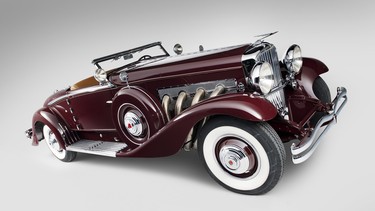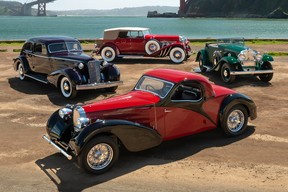A Mercedes-Benz 300SL, a one-of-five Pierce-Arrow Silver Arrow, and George Lucas’ Tucker 48 call Academy of Art University home, but the school’s president, Dr. Elisa Stephens, is set on modernizing the collection for the next generation

Article content
The 1955 Mercedes-Benz 300SL “Gullwing,” 1948 Tucker “Torpedo,” and 1935 Duesenberg SJ Convertible Coupe in the collection of San Francisco’s Academy of Art University (AAU) have two unique traits in common: they are all exceedingly rare automobiles, easily worth a million dollars each or more; and, strikingly, they all wear shades of maroon or purple.
Advertisement 2
Story continues below
Article content
If you want to get technical, the Duesenberg is Dark Garnet Red, the Tucker is Royal Maroon, and the Gullwing was born silver, but restored in Benz’s much-rarer Raspberry Red Metallic; the point is, they’re not the hues in which you typically see these models. “I do like purple, I do like lilac,” says the University’s president, Dr. Elisa Stephens. “But that Gullwing was [previously] owned by Jenny Craig—that was her colour,” she explains, noting the arguably feminine finish seemed to give pause to several bidders when she bought the car at auction in 2009, scoring her a rather good deal.
In fact, Stephens wasn’t closely considering the cars’ colours at all when she acquired them—the plethora of purple in the university’s collection is pure coincidence. What she was bearing in mind was how each car fit in with – or stood apart from – its contemporaries, aesthetically. “A big portion of the collection is based on styling, and […] changes in style, leaps in design, whether positive or negative.”
Advertisement 3
Story continues below
Article content
Advertisement 4
Story continues below
Article content
That’s because half the point of the Academy of Art University’s car collection is to function as a teaching aid for the students in the institution’s School of Industrial Design, led by executive director Tom Matano (yes, that Tom Matano, formerly chief designer for Mazda and one of the principal stylists behind the first-gen MX-5 Miata).
Over the past 25 years, the collection – it also doubles as a museum, open to the general public – has swelled to, currently, somewhere in excess of 150 cars, the rarities named above sharing space with some stunning pre-war marques, including Pierce-Arrow, Packard, Delage, and Talbot-Lago. But the university is ramping up efforts to modernize the collection, Stephens working with Matano and curator Wayne Barnes on balancing the proportion of its cars built after 1960. That means selling some absolutely gorgeous specimens like the aforementioned Tucker—and picking up a few muscle cars and Mazdas.
Advertisement 5
Story continues below
Article content
Pierce-Arrows, Packards, and yet more pink and purple
Advertisement 6
Story continues below
Article content
The university was founded in 1929 by Richard S. Stephens, then the creative director for Sunset magazine, as the Académie of Advertising Art, with classes held in a rented loft. Today, the Academy of Art University campus is spread across 45 facilities in downtown San Francisco, and boasts a student population of around 7,000.
It also boasts one of the country’s few car design programs, as well as an automotive restoration degree, started about a quarter-century ago by brothers Jeff and Rick Teague, sons of renowned industrial designer Dick Teague, the one-time vice-president of design for American Motors responsible for the AMC Gremlin and Jeep Cherokee XJ. The university’s car collection was built almost in lockstep, beginning in about 2005 with a 1929 Packard that Stephens – granddaughter of founder Richard S. – bought at auction for her father, former AAU president Richard A. Stephens, on his birthday.
Advertisement 7
Story continues below
Article content
“He had a broad sensibility of the classic car, because he was born in 1925 and had been raised in Paris, [and] Europe simply didn’t have cars then,” Stephens says of her dad. “When he came back to the United States in the ’30s, America had cars, and so as a young child, he fell in love with cars and was, I think, mesmerized by them.”
Recommended from Editorial
The elder Stephens’ fascination with that specific era of motoring has certainly rubbed off on his daughter; asked to recount some of her favourites from the collection, she dives enthusiastically into the details of a unique 1927 Packard. “It’s a 343, and it’s fitted with a Murphy convertible sedan body, believed to be the only surviving example,” Stephens gushes. “The body was designed by W. Everett Miller, and it incorporated thin ‘Clear-Vision’ cast-brass pillars.” The one-time Pebble Beach concours Best in Show winner was – if you hadn’t already guessed – finished in lilac under prior ownership.
Advertisement 8
Story continues below
Article content
In most car collections, such an incredible Packard would be the centerpiece; at the Academy of Art University Automobile Museum, it’s just one of several jaw-droppers, parked fender to fender with, for example, a rakish, streamlined Pierce-Arrow Silver Arrow, one of five built, and three surviving. “We had several Pierce-Arrows—my father was crazy about them,” says Stephens. “He felt they showed a great deal of honesty and integrity in their design.”
Other cars entered the collection through connections the university had made via alumni. The one-of-51-made 1948 Tucker “Torpedo” was acquired, for example, from George Lucas, himself a car buff who acted as executive producer on the film about the car’s creator, Tucker: The Man and His Dream. “George Lucas, when he was making all his Star Wars movies, hired a tremendous number of our illustrators and animators,” says Stephens. “And we wanted to have an example of that car, and I think it was in reach because it was from the Bay Area.”
Advertisement 9
Story continues below
Article content
Ta-ta, Tucker Torpedo; come here, Camaro and Corvette
Advertisement 10
Story continues below
Article content
The Tucker inspired many an AAU car-design student since Stephens picked it up in 2005, we’re sure, but its role as muse to curious young minds is over—the university sold the car at Broad Arrow Auctions’ Monterey, California event mid-August 2024, for a tidy US$1,380,000 sum. It’s not the only classic to leave the collection recently.
After hitting a peak of some 250 cars, the Academy of Art University auctioned off some 30 of them at a Mecum Las Vegas sale in 2018, for US$3.7 million. Then, in May 2019, four more cars were sold off for US$467,500. Another 15 went out the door in August 2019, netting the AAU some US$1.69 million in return. Prior to the Tucker’s changing hands, the most recent change-up in the collection’s makeup was the sale of four more cars at Broad Arrow’s 2023 Monterey auction, including a 1930 Duesenberg Model J Murphy Convertible Sedan.
Advertisement 11
Story continues below
Article content
A number of those departures were of “duplicates,” cars similar in model, year, or body style to an analogue still in the Academy of Art University Collection—but that doesn’t mean they were any easier for Stephens to let go of. “Even though they’re the same car, you’re not talking about identical twins,” she says. “No matter what, it’s difficult, because the cars are beautiful. But you kind of have to do it.”

Stephens says “have to” because the space freed up by letting go of those masterpieces creates a necessary vacuum for her to fill with more modern examples of automotive engineering, cars that may be more relevant to today’s younger generation of art and design student, and some of which they may even be able to drive. It’s an effort the university’s president has been working on for some years with the institution’s automotive advisor Wayne Barnes, as well as Industrial Design executive director Tom Matano.
Advertisement 12
Story continues below
Article content
Matano’s involvement in styling the Mazda Miata made an NA-generation MX-5 one of the first additions to this new Academy of Art University Automobile Museum, though of course the sports-car icon would have found its way into the collection on its own merit eventually anyway. The AAU has a Mazda RX-7, as well, along with a third-generation (A70) Toyota Supra Turbo. A Datsun 240Z made the list as well, and more recently Stephens was eyeing a ’69 Chevrolet Camaro.
“[Matano] and the instructors had ideas for some cars that would show designs relevant from the past to the present. And we realized, too, that a lot of people today, given the generation, love the muscle car, because they grew up with it,” explains Stephens.
Advertisement 13
Story continues below
Article content
Advertisement 14
Story continues below
Article content
(Stephens, despite her taste for some of the most achingly gorgeous pre-war U.S. and European pre-war luxury marques, arguably grew up with some American muscle, too: her very first car was a black 1985 Ford Mustang convertible her father gifted her when she graduated law school. She still has it.)
“We wanted a split-window [1963 Chevrolet] Corvette, so we were able to get a split-window Corvette,” she says of some newer acquisitions. “We wanted to show technology, so we were able to get on the list and purchase the new Ford GT.”
Advertisement 15
Story continues below
Article content
The modernization of the Academy of Art University’s car collection is mirrored by Stephens and Matano expanding the school’s automotive design program in new and innovative ways, too, most recently, for example, in the AAU teaming up with Stellantis on a co-op-style course. “They now have a design studio in partnership with us, so our students are doing on-site internships in the studio, with Stellantis,” says Stephens.
It all makes for an incredible way to learn about automotive styling in depth. “We’ve always wanted to be able to impact the next generation of car designers through education, and that’s what we were able to do,” Stephens says. “And by having a classic car collection, the students can come down and draw it, see it, smell it, design from it.”
“I think that’s the key, here—the alignment with our philosophy to preserve and create, to pass on these designs to future generations. It’s part of the legacy.”
Sign up for our newsletter Blind-Spot Monitor and follow our social channels on X, Tiktok and LinkedIn to stay up to date on the latest automotive news, reviews, car culture, and vehicle shopping advice.
This post was originally published on this site be sure to check out more of their content











































Comments